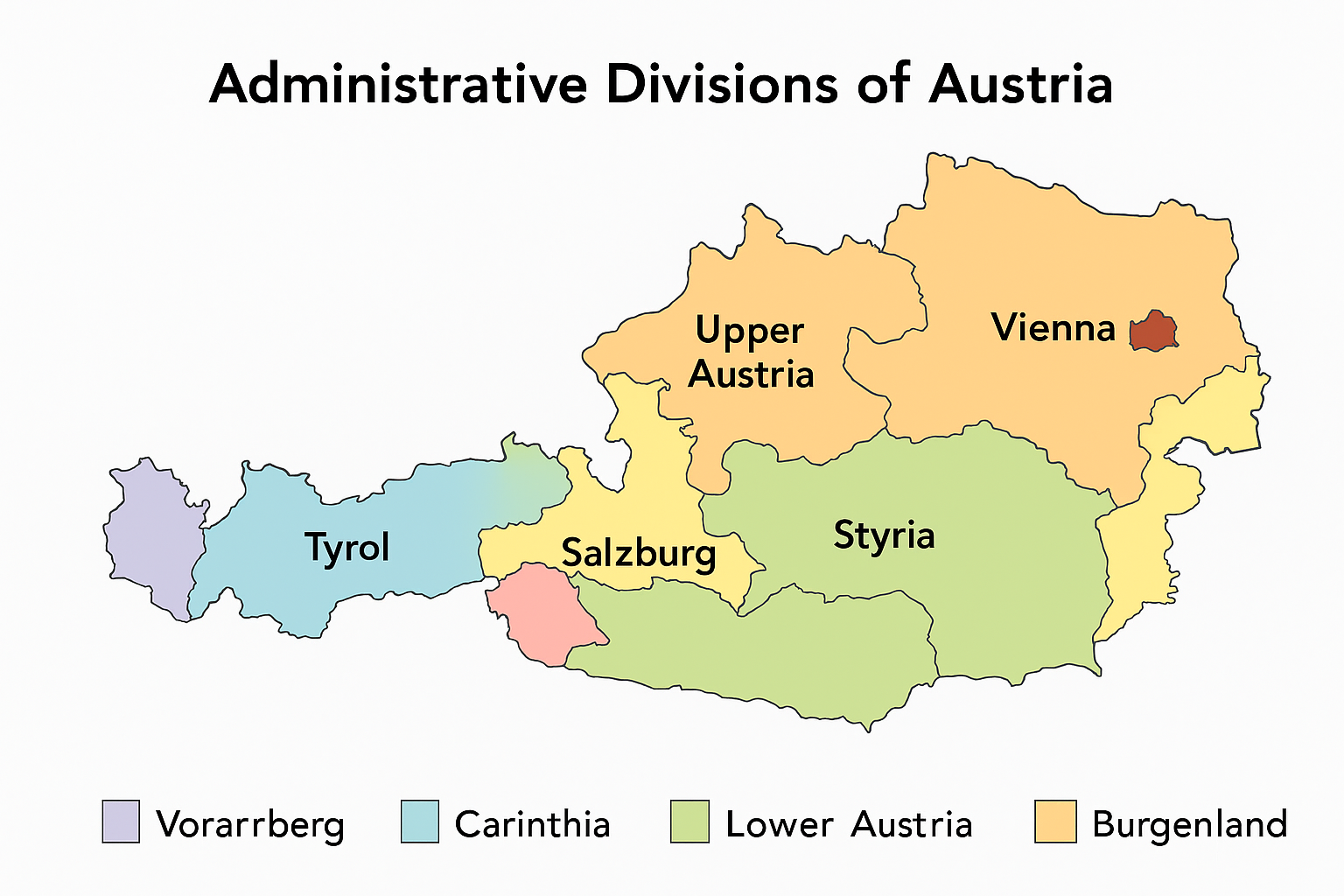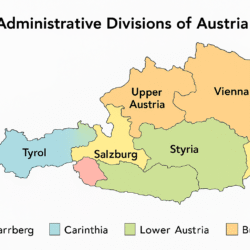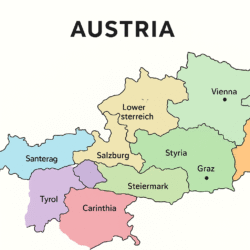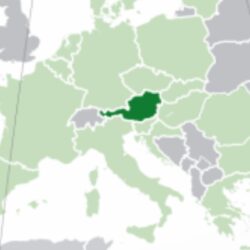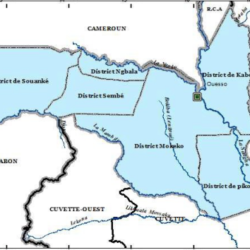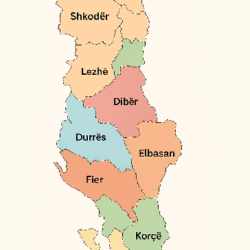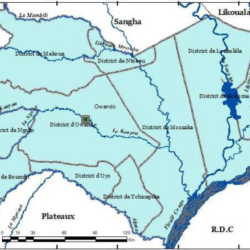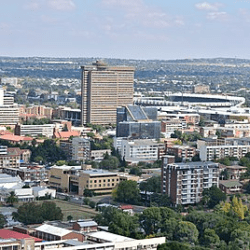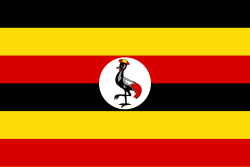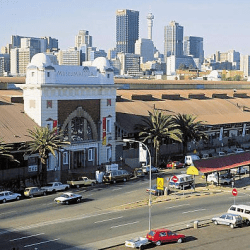Profiles of each of the nine federal states (Länder) of Austria, including the number of districts, municipalities, major economic sectors and notable features. I’ll also include a map-based breakdown of how the districts and municipalities are distributed across Austria.
State Profiles
1. Burgenland
ive structure: Part of the nine-Länder system.
- Municipalities: Austria in total has about 2,096 municipalities as of recent count.
(Exact current count for Burgenland may vary but the principle holds.) - Economy & sector notes: Burgenland is known for agriculture, wine production (especially in the Neusiedl region), and increasingly for renewable energy (wind farms, solar).
- Highlights: It is Austria’s easternmost Land, borders Hungary, and has relatively low population density compared to Austria’s more urban states.
2. Carinthia (Kärnten)
- Capital: Klagenfurt.
- Area: ~9,536 km².
- Population: ~561,077 (1 Jan 2017).
- Key sectors: Tourism (Alpine lakes, mountains), hydropower, light manufacturing.
- Administration: Includes a mix of mountain and valley municipalities, which poses logistical challenges for infrastructure and services.
3. Lower Austria (Niederösterreich)
- Capital: Sankt Pölten.
- Area: ~19,178 km².
- Population: ~1,665,753 (1 Jan 2017).
- Economy: A highly diversified economy — agriculture (wine, grain), manufacturing, services; close to Vienna so substantial commuter flows.
- Administration: Being the largest Land by area, it has many municipalities, including both small rural ones and larger towns.
4. Salzburg (state)
- Capital: Salzburg (city).
- Area: ~7,154 km².
- Population: ~549,263 (1 Jan 2017).
- Key features: Strong tourism sector (heritage city + Alps), music and culture (Mozart), alpine manufacturing and outdoor-industry clusters.
- Municipalities & districts: Mix of valley municipalities and mountainous ones — local administration has to deal with tourism management as well as local services.
5. Styria (Steiermark)
- Capital: Graz.
- Area: ~16,401 km².
- Population: ~1,237,298 (1 Jan 2017).
- Economy: Known as “the green heart of Austria” — extensive forests, mix of agriculture, strong industrial/trade sectors (especially around Graz), as well as research/university presence.
- Administration: A mix of large urban municipalities (Graz) and quite rural, mountainous municipalities in the south and east.
6. Tyrol (Tirol)
- Capital: Innsbruck.
- Area: ~12,648 km².
- Population: ~746,153 (1 Jan 2017).
- Key sectors: Alpine tourism (skiing, hiking), winter sports, manufacturing (especially metal and machining industries), high value tourism.
- Municipal and district issues: Many municipalities are in mountainous terrain, which impacts delivery of public services, accessibility, transport.
7. Upper Austria (Oberösterreich)
uring, steel, chemical industries, logistics (Danube corridor).
- Administration: A significant number of municipalities, including many larger towns in the Danube/Inn corridors as well as rural ones.
8. Vienna (Wien)
t is both a federal state (Land) and a statutory city (Statutarstadt) with district-level competencies.
- Area: ~415 km².
- Population: ~1,867,582 (1 Jan 2017).
- Economy: Capital city functions (government, culture, commerce), very high population density (~4,500 /km²) in the given data.
- Administration: Since it is both Land and municipality, governance structures are streamlined relative to multi‐tier states; the municipal government handles many tasks.
9. Vorarlberg
- Capital: Bregenz.
- Area: ~2,601 km².
- Population: ~388,752 (1 Jan 2017).
- Economy: Westernmost Austrian state, border to Switzerland and Germany, strong in precision engineering, wood‐industry, alpine tourism; higher GDP per capita noted.
- Municipal structure: Smaller geographic size but many municipalities; mountainous terrain means many small local governments.
Map-based Breakdown of Districts and Municipalities
utarstädte).
- As of recent counts: Approximately 94 districts (of which 15 are statutory cities) in Austria.
- Municipalities (Gemeinden) in Austria: roughly 2,096 as of 2020.
- Hence the hierarchy: Land → District (or statutory city) → Municipality.
- The maps above visualize how many districts each Land has, how municipalities are distributed especially in rural vs urban zones.
Observations from the map patterns
- The eastern states (Lower Austria, Burgenland) have relatively large flat or gently hilly areas with many municipalities, some of which are small.
- Alpine states (Tyrol, Salzburg, Vorarlberg) have municipalities more spread vertically (along valleys) and smaller in population, more numerous in number relative to area, due to terrain.
- Urbanised states (Vienna, Upper Austria with Linz, Styria with Graz) show clustering of municipalities around metropolitan centres; statutory cities simplify some administrative layers.
- Statutory cities: In some states certain large cities function as both municipality and district level — this is visible on maps as distinct units.
Additional Notes & Governance Implications
- The number of municipalities is subject to reform: small municipalities are often challenged by declining population, cost of delivering services, and infrastructure maintenance. As such, some Länder encourage municipal mergers or increased cooperation among municipalities.
- District level (Bezirk) provides services like local offices, some supervision of municipalities, but in statutory city areas the city administration takes those district tasks directly.
- Geographic diversity across the Länder (from Danube plains to high Alps) means municipal and district administration must adapt to terrain, population density, and infrastructure needs (e.g., mountain transport, seasonal tourism).
- Fiscal and administrative capacity varies: Urban municipalities tend to have stronger tax bases; very rural municipalities may rely heavily on inter-governmental transfers or cooperative structures.
